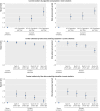Impact of smoking and smoking cessation on cardiovascular events and mortality among older adults: meta-analysis of individual participant data from prospective cohort studies of the CHANCES consortium
- PMID: 25896935
- PMCID: PMC4413837
- DOI: 10.1136/bmj.h1551
Impact of smoking and smoking cessation on cardiovascular events and mortality among older adults: meta-analysis of individual participant data from prospective cohort studies of the CHANCES consortium
Abstract
Objective: To investigate the impact of smoking and smoking cessation on cardiovascular mortality, acute coronary events, and stroke events in people aged 60 and older, and to calculate and report risk advancement periods for cardiovascular mortality in addition to traditional epidemiological relative risk measures.
Design: Individual participant meta-analysis using data from 25 cohorts participating in the CHANCES consortium. Data were harmonised, analysed separately employing Cox proportional hazard regression models, and combined by meta-analysis.
Results: Overall, 503,905 participants aged 60 and older were included in this study, of whom 37,952 died from cardiovascular disease. Random effects meta-analysis of the association of smoking status with cardiovascular mortality yielded a summary hazard ratio of 2.07 (95% CI 1.82 to 2.36) for current smokers and 1.37 (1.25 to 1.49) for former smokers compared with never smokers. Corresponding summary estimates for risk advancement periods were 5.50 years (4.25 to 6.75) for current smokers and 2.16 years (1.38 to 2.39) for former smokers. The excess risk in smokers increased with cigarette consumption in a dose-response manner, and decreased continuously with time since smoking cessation in former smokers. Relative risk estimates for acute coronary events and for stroke events were somewhat lower than for cardiovascular mortality, but patterns were similar.
Conclusions: Our study corroborates and expands evidence from previous studies in showing that smoking is a strong independent risk factor of cardiovascular events and mortality even at older age, advancing cardiovascular mortality by more than five years, and demonstrating that smoking cessation in these age groups is still beneficial in reducing the excess risk.
© Mons et al 2015.
Conflict of interest statement
Competing interests: All authors have completed the ICMJE uniform disclosure form at
Figures





Comment in
-
Risk factors: More data to encourage current cigarette smokers to quit.Nat Rev Cardiol. 2015 Jun;12(6):320. doi: 10.1038/nrcardio.2015.70. Epub 2015 May 5. Nat Rev Cardiol. 2015. PMID: 25940923 No abstract available.
References
-
- US Department of Health, Education, and Welfare. Smoking and Health: Report of the Advisory Committee to the Surgeon General of the Public Health Service. Washington, DC: US Public Health Service. Office of the Surgeon General, 1964.
-
- US Department of Health and Human Services. The health consequences of smoking—50 years of progress. A Report of the Surgeon General. Atlanta, GA: US Department of Health and Human Services, Centers for Disease Control and Prevention, National Center for Chronic Disease Prevention and Health Promotion, Office on Smoking and Health, 2014.
-
- Ford ES, Capewell S. Proportion of the decline in cardiovascular mortality disease due to prevention versus treatment: public health versus clinical care. Annu Rev Public Health 2011;32:5-22. - PubMed
-
- Kriekard P, Gharacholou SM, Peterson ED. Primary and secondary prevention of cardiovascular disease in older adults: a status report. Clin Geriatr Med 2009;25:745-55. - PubMed
Publication types
MeSH terms
Grants and funding
LinkOut - more resources
Full Text Sources
Other Literature Sources
Medical
